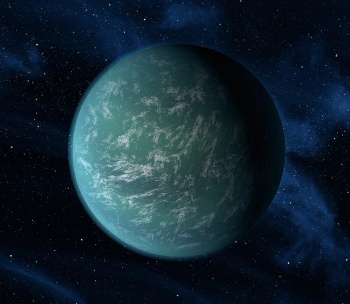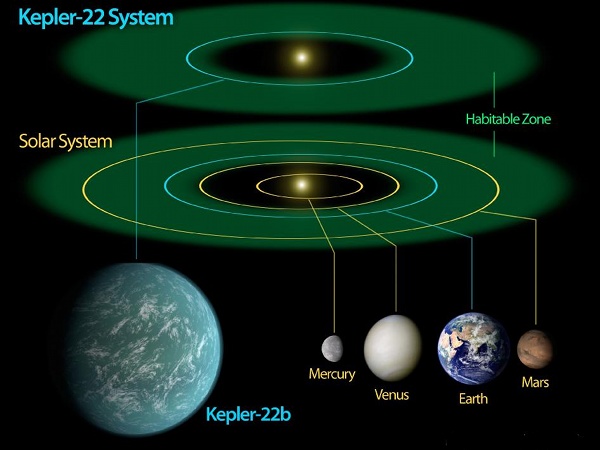Terrestrial Planets
December 8, 2011
One of the earliest
theories of the
formation of the Solar System was the encounter hypothesis in which a passing star extracted material from our Sun that coalesced into the planets. This theory had one main flaw, that hot gas will expand, not contract. If the encounter hypothesis was the way that planets form, then
planetary systems would be rare, indeed, and we shouldn't bother ourselves looking for
exoplanets (a.k.a., extrasolar planets), or doing
SETI.
The more likely scenario for planetary formation is the
nebular hypothesis in which the
Sun and its planets coalesced from the same large cloud of gas. This theory is associated with
Laplace, who published it in 1796, although
Emanuel Swedenborg and
Immanuel Kant proposed the same idea prior to Laplace. The nebular hypothesis left some things unexplained, such as why the planets have 99% of the
angular momentum in the Solar System, so it wasn't taken seriously until such issues were sorted out later in the
twentieth century.
The nebular hypothesis is now the current model for planetary formation, but it's hard to decide on a theory's validity with just one example. That's usually derided by
scientists as just
anecdotal evidence. Fortunately, in the last few decades, nearly a thousand extrasolar planets have been discovered in hundreds of stellar systems.[1]
Occam's razor appears to be cutting on the side of the nebular hypothesis, although most of the detected solar systems are quite unlike our own.
Our concept of life requires a set of
chemical conditions, such as the presence of
water. At present, it's difficult to ascertain the chemistry of an extrasolar planet, but one thing that's easy to do, at least with our advanced
astrometric technology, is to estimate a planet's
temperature. For any stellar system, it's possible to map an
orbital region, called the
habitable zone, where life as we know it won't be
frozen, or
boiled out of existence.
Gas giant planets, like our own
Jupiter, are quite common. Earth-like, or terrestrial planets are not that common, and planets in the habitable zone are rarer still. The first candidate terrestrial planet was
Gliese 581 g, which I wrote about in a
previous article (Gliese 581 g, October 1, 2010). The host star,
Gliese 581 (Right Ascension 15h 19m 26s, Declination 07° 43' 20") is just 20.5
light years distant from Earth, in the constellation
Libra.
Astrometry of extrasolar planets is a difficult task with compounding measurement errors, and there is even some controversy as to whether Gliese 581 g actually exists. If it really does, it's squarely in the habitable zone of its star. Gliese 581 g does have the peculiarity that it's
tidally locked to its star; that is, one face of the planet always faces its star. The planet's
mass, about three times
Earth's mass, would
keep an atmosphere from escaping into space.
Gliese 581 g, if it does exist, is just barely Earthlike, so there was much more excitement in the recent announcement of another extrasolar planet,
Kepler-22b.[2-5] Kepler-22b is named after the
Kepler spacecraft, launched in March, 2009, whose sole purpose is to find extrasolar planets. Kepler has thus far discovered 1,094 extrasolar planet candidates, but all of these must be vetted through careful observations by ground-based telescopes and the
Spitzer Space Telescope before confirmation. Kepler-22b is about 2.4 times the radius of Earth,[2] so it isn't really Earth's twin.[5]

Artist's conception of Kepler 22b, an Earth-like planet that's been discovered to orbit in the habitable zone of its star.
(Image: NASA/Ames/JPL-Caltech))
Kepler's mission is to observe
transits across more than 150,000 stars, and it needs to observe at least three transits to qualify the existence of an exoplanet. Kepler-22b was fortunately observed just three days after the spacecraft became operational. Since its orbital period is 290 days, this meant that 580 days were required to cycle through three transits.[2] The third transit occurred about a year ago at this time, so the media are calling Kepler-22b the "Christmas Planet."
Kepler-22b is located 600
light-years away, and its host star is
G-type, the same
stellar classification as the Sun, but somewhat smaller and cooler.[3] The latest extrasolar planet scorecard lists 207 Earth-sized planets, 680 larger than the Earth, 1,181
Neptune-sized, 203 Jupiter-sized, and 55 larger than Jupiter.[2] The official summary of the discovery data will be published in
The Astrophysical Journal.[2]

An illustration of the Kepler-22b system compared to our Solar System. (Image: NASA/Ames/JPL-Caltech).
References:
- Habitable Exoplanets Catalog, University of Puerto Rico, Arecibo Campus.
- Michele Johnson and Trent J. Perrotto, "NASA's Kepler Confirms Its First Planet in Habitable Zone of Sun-like Star," NASA Ames Research Center Press Release No. 11-99AR, December 5, 2011.
- Michele Johnson, "NASA's Kepler Mission Confirms Its First Planet in Habitable Zone of Sun-like Star," NASA Ames Research Center Press Release, December 5, 2011.
- Abel Mendez, "The Habitable Exoplanets Catalog, a new online database of habitable worlds," University of Puerto Rico, Arecibo Campus, Press Release, December 5, 2011.
- Robert J Sawyer, "Viewpoint: The obsession with a 'twin Earth'," BBC News, December 7, 2011.
Permanent Link to this article
Linked Keywords: Theory; formation of the Solar System; planetary systems; extrasolar planet; exoplanet; search for extraterrestrial intelligence; SETI; nebular hypothesis; Sun; Pierre-Simon Laplace; Emanuel Swedenborg; Immanuel Kant; angular momentum; twentieth century; scientist; anecdotal evidence; Occam's razor; chemical conditions; water; sstrometry; astrometric; temperature; orbital region; habitable zone; frozen; boiled; gas giant planet; Jupiter; Gliese 581 g; Gliese 581; light year; Libra; tidal locking; mass; Earth's mass; atmospheric escape; Kepler-22b; Kepler spacecraft; Spitzer Space Telescope; NASA/Ames/JPL-Caltech; transit; G-type; stellar classification; Neptune; The Astrophysical Journal; Habitable Exoplanets Catalog; University of Puerto Rico; Arecibo.